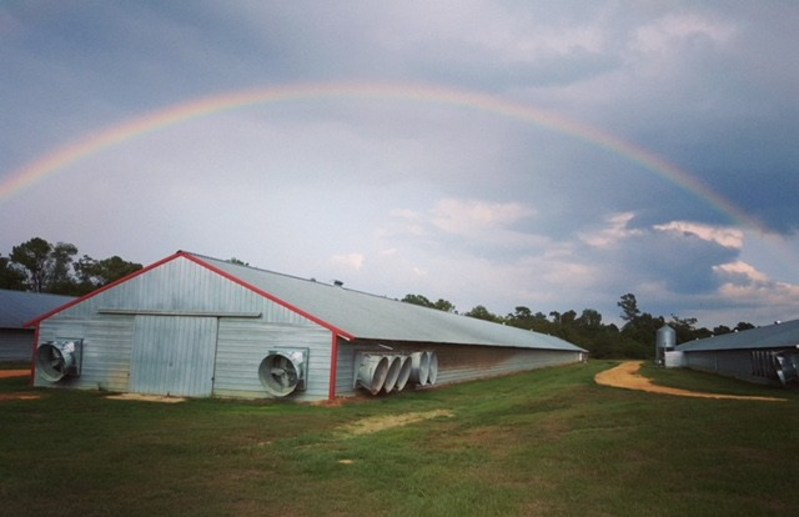LAUREL, Miss., March 6, 2018 /PRNewswire/ — The majority of Americans have never been on a real farm. Americans’ lack of knowledge and understanding about agriculture is because most Americans are three or more generations removed from the farm. Having never experienced rural life, some are easily convinced that the stereotype of the “factory farm” is true. In reality, of the United States’ 2.1 million farms, 99% are owned and operated by farm families.
The Harrison Family Farm
Making up only 2% of the American population, these dedicated farming families shoulder a disproportionate load in supporting the United States economy, their local communities, and literally feeding the world. Farming contributes almost $137 billion to the U.S. gross domestic product, and one U.S. farm feeds an average of 165 people each year.
One hundred years ago, agriculture was labor intensive, taking place on many diversified farms. In those days, more than half of the U.S. population lived in rural areas. Today, technological developments have allowed for specialization and increased productivity, while decreasing the amount of land, labor, and natural resources required. Today, less than a fourth of the U.S. population still lives in these rural areas. Agriculture has changed drastically over the last century, but family farmers remain a constant.
“When I grew up, farming was all hand labor – no machinery,” said Terry Harper, a Sanderson Farms farmer in Adel, Georgia. “Thanks to research and advancement within the industry, it’s now much easier to operate a farm, and we’re able to provide our animals with a better environment to live and grow.”
Each year, consumers spend over $1 trillion on food grown by U.S. farmers and ranchers. When family farms thrive, so do the businesses in the surrounding communities, due to the “local multiplier effect.” This positive effect occurs when locally owned businesses spend the money they make in their own communities, boosting local economic activity and job creation. In fact, small businesses, such as family farms, have generated 64% of all new jobs since 1995.
“As I’ve learned more about how the agriculture industry is connected, I’ve discovered how much of an impact my farm has on surrounding businesses, such as the hen farm behind ours,” said Tim Elsey a farmer with Sanderson Farms in Collins, Mississippi. “Farming not only provides for my family, but supports my neighbors and their families.”
In some rural communities, agriculture is the primary driver of economic activity and supports the majority of the population in employment. One of the pillars of Sanderson Farms’ business is a strong belief in the importance of giving back to the communities in which they operate. Farmers fit well into this model, as they are deeply rooted in the areas where they work and also serve as natural stewards of the land. That’s why poultry producers, like Sanderson Farms, which partners with over 900 farmers across the Southeast, choose to form business relationships with family farmers to grow their chicken.
“The farm isn’t just for our family, it’s beneficial to the community,” said Chris Agapiou, a Sanderson Farms farmer in Palestine, Texas. “Knowing we are producing something that helps our neighbors makes us feel like we’re making a difference in the world.”
GOT NEWS? click here
Google News, Bing News, Yahoo News, 200+ publications
Indeed, these farmers are not just making a difference, they are feeding the world. In 2017, family farms across the United States produced over 41 billion pounds of affordable chicken that not only fed Americans, but was also exported to countries across the globe.
Reasons for entering the occupation vary from farmer to farmer. Some are continuing a tradition passed down for generations, and others enter the profession with little prior knowledge and an eagerness to learn. Most farmers agree, however, that while the job is difficult, it’s worth it. Farming provides families with an opportunity for financial self-sufficiency and the freedom that comes along with being self-employed.
“There is an endless supply of rewards that comes along with farming,” said Christie Harrison, a Sanderson Farms farmer in Collins, Mississippi. “To be able to have my family with me every day and to partner with a family-oriented company, that’s worth its weight in gold.”
Please click here to view the digital press kit for photos and more.
![]() View original content with multimedia:http://www.prnewswire.com/news-releases/ag-industry-misconceptions-flourish-family-farmers-remain-steadfast-300609075.html
View original content with multimedia:http://www.prnewswire.com/news-releases/ag-industry-misconceptions-flourish-family-farmers-remain-steadfast-300609075.html
SOURCE Sanderson Farms







